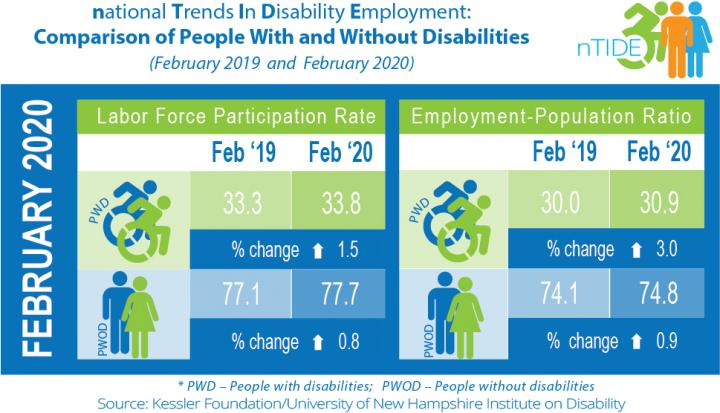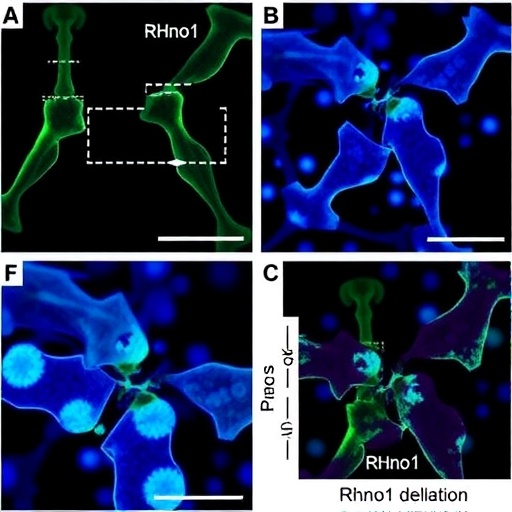Kessler Foundation & University of New Hampshire nTIDE Report — featuring PROMISE: Promoting Readiness of Minors in Supplemental Security Income Project – a holistic approach to improving outcomes for young people with disabilities and their families

Credit: Kessler Foundation/Jody Banks
East Hanover, NJ – March 6, 2020 – Modest jobs gains continued for people with and without disabilities in February, according to today’s National Trends in Disability Employment – Monthly Update (nTIDE), issued by Kessler Foundation and the University of New Hampshire’s Institute on Disability (UNH-IOD).
In the Bureau of Labor Statistics (BLS) Jobs Report released Friday, the employment-to-population ratio for working-age people with disabilities increased from 30 percent in Feb. 2019 to 30.9 percent in February 2020 (up 3 percent or 0.9 percentage points). For working-age people without disabilities, the employment-to-population ratio also increased from 74.1 percent in Feb. 2019 to 74.8 percent in February 2020 (up 0.9 percent or 0.7 percentage points). The employment-to-population ratio, a key indicator, reflects the percentage of people who are working relative to the total population (the number of people working divided by the number of people in the total population multiplied by 100).
“The labor market’s continuing strength should be reassuring for workers with disabilities,” said John O’Neill, PhD, director of the Center for Employment and Disability Research at Kessler Foundation. “The consecutive gains over the last three months in the employment-to-population ratio is positive news for people with disabilities. However, there’s great uncertainty regarding the COVID-19 epidemic, and its potential to disrupt labor markets.”
The labor force participation rate for working-age people with disabilities increased from 33.3 percent in Feb. 2019 to 33.8 percent in Feb. 2020 (up 1.5 percent or 0.5 percentage points). For working-age people without disabilities, the labor force participation rate also increased from 77.1 percent in February 2019 to 77.7 percent in February 2020 (up 0.8 percent or 0.6 percentage points). The labor force participation rate is the percentage of the population that is working or actively looking for work.
“Throughout 2018 and 2019, the labor market was fairly flat for people with disabilities, so it is good to see people with disabilities keeping pace with people without disabilities over the last three months,” said economist Andrew Houtenville, PhD, research director of the University of New Hampshire’s Institute on Disability. “As efforts to contain the spread of COVID-19 expand, our thoughts are with everyone, as they cope with changes affecting their work arrangements and personal circumstances.”
In February 2020, among workers ages 16-64, the 4,719,000 workers with disabilities represented 3.2 percent of the total 147,172,000 workers in the U.S.
Beyond the Numbers
Achieving independence is a complicated pathway for youth with disabilities, a group that has low graduation rates and difficulties transitioning to postsecondary education and the workforce. This is true especially for recipients of Supplemental Security Income (SSI), who reach a crossroads at age 18 when their future eligibility is redetermined using adult criteria for gainful employment. More than 60% qualify for SSI as adults, leading to widespread long-term dependence on SSI, and contributing to the high poverty rates in this population.
To improve socioeconomic outcomes among these high-risk youth and their families, a five-year, $36 million randomized controlled trial was launched in 2013, called PROMISE – Promoting Readiness of Minors in Supplemental Security Income Project”. PROMISE, which enrolled 13,444 participants in six model demonstration projects covering 11 states, was funded through a federal agency partnership of the US Department of Education, the Social Security Administration, the US Department of Health and Human Services, and the US Department of Labor. Centered on 14-16 year olds, PROMISE implemented culturally responsive experimental interventions for transitioning youth, as well as family members, a dual-generation approach aimed at increasing transition to higher education and competitive integrated employment. Participants were randomized to either the treatment group (experimental interventions), or the control group (traditional services).
Essential elements of the treatment included the provision of case management, work experiences, information and training for parents, and counseling that included benefits planning, financial literacy, and career services. Each project developed partnerships with state agencies and community organizations, and had access to a dedicated technical assistance center (PROMISE TA Center)* for support including professional development for stakeholders.
Preliminary outcomes for PROMISE show improvement in employment with the experimental model compared with traditional services. “Grounding this comprehensive service model in the dual-generation approach established the basis for success,” said John O’Neill, PhD, director of the Center for Employment and Disability Research at Kessler Foundation. “Many of these young people and their families have the capacity to improve their economic status through engagement in the workforce. Planning for transition needs to begin early, so families are aware of options beyond SSI that will help their children live as independently as possible,” he emphasized.
While much remains to be learned from the PROMISE trial, preliminary data are encouraging, according to experts at Mathematica and the University of Minnesota who are analyzing the results. “Outcomes for young recipients of SSI will improve through family engagement and person-centered services delivered in an environment where services are coordinated and systems collaboration is supported,” Dr. O’Neill concluded.
###
*The TA Center, funded through grant H418T140002 from the Office of Special Education Programs to the Association of University Centers for Disability (AUCD), is a collaborative project of AUCD, Institute on Community Integration, and the University of Minnesota’s UCEDD.
Ask Questions about Disability and Employment
Each nTIDE release is followed by a nTIDE Lunch & Learn webinar at 12:00 pm Eastern. This live broadcast, hosted via Zoom Webinar, offers attendees Q&A on the latest nTIDE findings, and provides news and updates from the field, as well as invited panelists to discuss current disability-related findings and events. On March 6, PROMISE experts Kelly Nye-Lengerman, PhD, and David R. Johnson, PhD, from the University of Minnesota, join Dr. O’Neill, and Denise Rozell, Policy Strategist at AUCD. Join live or access the nTIDE archives at: ResearchonDisability.org/nTIDE.
NOTE: The statistics in the nTIDE are based on Bureau of Labor Statistics numbers but are not identical. They are customized by UNH to combine the statistics for men and women of working age (16 to 64). nTIDE is funded, in part, by grants from the National Institute on Disability, Independent Living and Rehabilitation Research (NIDILRR) (90RT5037) and Kessler Foundation.
About Kessler Foundation
Kessler Foundation, a major nonprofit organization in the field of disability, is a global leader in rehabilitation research that seeks to improve cognition, mobility, and long-term outcomes — including employment — for people with neurological disabilities caused by diseases and injuries of the brain and spinal cord. Kessler Foundation leads the nation in funding innovative programs that expand opportunities for employment for people with disabilities. For more information, visit KesslerFoundation.org.
About the Institute on Disability at the University of New Hampshire
The Institute on Disability (IOD) at the University of New Hampshire (UNH) was established in 1987 to provide a coherent university-based focus for the improvement of knowledge, policies, and practices related to the lives of persons with disabilities and their families. For information on the NIDILRR-funded Employment Policy and Measurement Rehabilitation Research and Training Center, visit ResearchonDisability.org.
For more information, or to interview an expert, contact:
Carolann Murphy, 973.324.8382, [email protected]
Media Contact
Carolann Murphy, PA
[email protected]
973-324-8382




